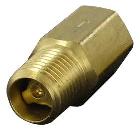The MGA With An Attitude
This is a scheme for cooling the carburetors to prevent fuel boiling (which results from use of alcohol in the fuel in hot weather). I haven't done this (yet), so no pictures.
Material: Brass Connection: 1/4 Male NPT inlet x 1/4 Female NPT outlet Dimensions: 1.41" x 11/16" Hex Cracking Pressure: 1.5 psi +/- 1/2 psi Flow Rates: 1.28 gpm @ 5 psi O-Rings: Buna-N FDA grade (Viton available by special order) The original SU fuel pump can deliver about 10 gallons per hour with minimal back pressure. The Airtex pump can do more than double that flow with moderate back pressure, which should result in at least 2 pints per minute passing the relief valve when the engine is idling with minimal fuel consumption. But that alone will not do much to cool the carbs during the worst heat standing still and idling conditions. With minimal (idle speed) fuel flow, the carburetors will still get hot, preheat fuel in the float chambers, and boil fuel in the throttle body as it enters the main jets (same as before). All the new system would do would be to cool the fuel a little in the pipe from heater shelf to the float covers. To make this work you have to cool the fuel in the float chambers, so flow from the bowls to the jets will cool the throttle body. But you can't bleed fuel from the float chamber for return to the tank, because the float chambers are at atmospheric pressure, and gravity feed would not return enough fuel to the tank, and if it did then the float valves may not pass enough fuel to keep the float bowls full. A viable solution would be to wrap the fuel return pipe several turns around the float bowl (with intimate thermal contact) to pull heat from the bowl to the return pipe. I imagine flattening the pipe for the coil to have better thermal contact between pipe and bowl (maybe even solder the pipe to the bowl wall). Then you have five local pipes (in addition to the two coil pipes), and ten pipe and hose connectors. Start with the original hose from heater shelf to rear banjo, substitute hose from rear banjo to front banjo, pipe or hose front banjo to front coil tube, pipe or hose front coil tube to rear coil tube, and hose from rear coil tube to heater shelf to flex connect to the return pipe. This is simple in theory, but a bit complex in practice. I decided to try the bilge blower first and it works, so I never got around to trying fuel recirculation. |
